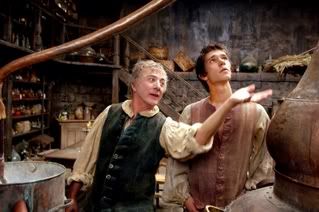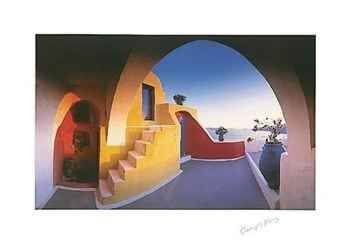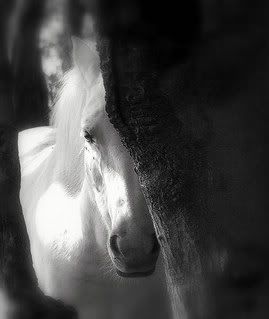
As you might have known if you have been reading PerfumeShrine long enough, this is a blog that aims to pose questions and make you ponder as much as anything. No ready "recipes" or flowery purple prose for the sake of it. So whenever we test something new and considered groundbreaking it is taken with several shakers of salt and what it conveys is really thought out before passing judgement.
As I elaborated on my previous post, much of the perfume world is revolving round the gimmick and the "perceived" value rather than the core definition of quality. So it is with these factors in mind that the Nasomatto line was being evaluated, for the first time in its entirety on any perfume blog, to the best of my knowledge.
Gimmick is too often the last refuge of brilliant advertisers and marketeers who have stumbled upon the block of too many fragrances out there and all competing for the same crowd. The niche world is by definition a smaller audience and to grab its attention some greater effort is required it seems.
For example what line could be more gimmicky that the rather new État Libre d'Orange? With the royally satiric tag line "Perfume is dead, long live perfume!" and with scent names such as Éloge du Traitre (=Praise of a Traitor), Nombrile Immense (=big belly button), the borderline porn smell of Sécretions magnifiques or the more outré still names of Putain de palaces (=palace whore) and Don't get me wrong baby, I don't swallow , the house that is using three Givaudan perfumers is bent on eliciting attention through their ox-feller presentation.
In contrast, Nasomatto Perfumes line is fairly subdued. Of course the manifesto is -predictably- wishing to break the mould and make for distinguished wearers, as you can attest by this:
I take advantage of what you always said about me
I take advantage of your sexual essence
I take advantage of drugs and food
I take advantage of my olfactive memory and trips
I take advantage of mistakes
I take advantage from the Z1
I take advantage of the best raw materials
I give advantage to people longing to distinguish themselves
The masterminds are both italian, Allesandro and Arturetto, who had been students in Germany at the H&R company for courses in "medieval" perfumery. We're told that Allesandro was taught by Arturetto and then went on to create fragrances for designers such as Romeo Gigli, Versace, Valentino, Helmut Lang and Fendi, finally locating in Amsterdam and re-uniting with Arturetto to launch his private vision: a line of his own niche perfumes, called Nassomato.
The line, comprised of 5 fragrances, is characterised by its heavy, fun, loud and individual style that isn't afraid to take risks and produce potent stuff. For what it's worth I think that there is a thin line between heavy and too heavy. And although much of the scented products of today fall into the inspid, too light, too fleeting camp which might generate continual re-spritzing and thus elevated consumption per ml, it does leave the consumer with a sense of wasting money down the drain, as ultimately they complain about the lack of sillage and staying power of scents compared to older classics. The tenacity of modern perfumes is usually achieved through synthetic enhancers and those leave something to be desired for as invariably the bases used are predictable and not as rich and nuanced as those of yore. In Nasomatto, the staying power is quite good for most of the fragrances in the line and it has to do with the high concentration of the juice as well: extrait de parfum in bottles capped with a square arhictectural wooden cap.
What is also noteworthy is that contrary to most lines, they absolutely do not issue notes for their perfumes, which can be a double-ended sword: good, because it leaves the consumer judge for what he/she smells per se and not what is led to believe is in there; and bad because -let's face it- so much of the niche fragrance buying is happening online, unsniffed, by people who wouldn't have access to such perfumes otherwise, who yet love being individual and so often it is such a disappointing experience to proceed in such a way...
So in the interests of helping along, here is what PerfumeShrine thought of each and every one of them:
Duro: Per the company blurb "the fragrance aims to enhance all the manifestations of male strength". Duro means strong and durable in italian and indeed this masculine scent with guts aims to hit bull's eye and not veer off the course for a second. It is bracing, leathery, with a character of strong affinities. I seem to detect patchouli and hints of grassy coffee in there which make for a dry and potent mix. It demands a wearer with some personality to carry it off, yet I can see that it is very modern and not something that could have been issued 2 or 3 decades before. It does not develop too much retaining the tonalities of the starting point well into the drydown.
Hindu Grass: This -to my nose- unisex scent "aims to breathe the belief in universal peace and love. It is the result of a quest for the warm affection of humanity". Of course it might require much more for universal peace and love, yet the fragrance blends what seems to be a very hippy-ish amount of herbs and grasses that smell dry, pleasant and lightly cooling, fit for any season. There is a hint of mint to my nose and it intermingles with other herbal notes and possibly some ionones to instill a sense of playful, serene walks in woods or grassy knolls, reading a book in the shade, cooling off with a glass of green tea.
Narcotic Venus: As its name suggests this is patently feminine, "the result of a quest for the overwhelming addictive intensity of female sexual power" and as one might surmiss is based on that most narcotic and potent flower of them all: tuberose. It marries to some other floral essences of a white nature which are not discernible per se and the sillage is loud and strong for those who have Fracas and Carnal Flower affinities and proclaiments. Venus it is and at its most predatory, on top. I suggest you proceed with caution, but if it fits it can be a great weapon in your arsenal.

Absinth: "The fragrance aims to evoke degrees of hysteria. It is the result of a quest to stimulate irresponsible behaviour" is what the company tells us. And frankly I cannot see why this would produce anything like hysteria, as it is a wonderful fragrance full of bittersweet notes of herbs, earthy pungent vetiver, possibly angelica or wormwood and some sweet element of vanillic florancy in there that accounts for the most delectable semi-gourmand effect possible. If this is how a modern aromatic gourmand should be made, then I'm all for it. It proved to be a favourite from the line, although I obviously liked a couple more and I can see how men and women alike who go for something individual would go for it. It lasts well, has a more subtle effect upon putting it on and then develops nicely and warm to the skin retaining its properties for a long long time. A winner!
Silver Musk: "The fragrance aims to evoke superhero magnetism. It is the result of a quest for mercurial liquid love sensation". Or so they say. For once more I am going to dispute part of the advertorial and say that this is a lovable very approachable clean musk with egyptian tendencies that on my skin was a bit close to the wonderful, elusive and very expensive Narciso Musk for her oil by Narciso Rodriguez, although not as gorgeous. They both seem to utilise the same synthesized musks that account for a cuddly, clean, erotic undertow that makes people approach a little closer and lean over wondering what is that magical spell that has gotten them entangled in your web. If you like that sort of ambience, you couldn't go wrong with Silver Musk. Possibly the easiest in the bunch and with good lasting power.
The company has their own site: click for the official Nasomatto site.
The line is available at First in Fragrance/Aus liebe zum Duft for now. Click here to sample/order. Each Nasomatto sample costs 4 euros and you can order a minimum of 15 euros just for samples on the FIF site.
They come in Extrait de Parfum in 30ml/1oz for 90 euros each.
And for those who comment on this post, we have proclaimed a little LUCKY DRAW!. Three SAMPLES of our choosing to go to them FREE of charge, so they can experience for themselves the new Nasomatto line. Just post a comment that you want to enter the lucky draw and you're in.
I will notify you about the lucky winner very soon.
Pic of bottle comes from First in Fragrance. Absinth glass pic courtesy of Wikipedia.
.jpg)










.jpg)

.jpg)
